
Research from Aarhus University reveals a startling link between noise pollution and increased violence, particularly around airports. The study found that a 4.1-decibel increase in noise pollution led to a 6.6% rise in violent crime, with men being most affected. The majority of this violence occurs during daytime hours and more frequently in summer. Annually, noise pollution causes 246 more violence victims in Frankfurt areas, and 1,033 additional incidents across Europe.
The health and environmental consequences of noise pollution
Noise pollution is more than just an annoyance; it has been linked to various health problems, such as stress, poor concentration, productivity loss, communication difficulties, fatigue, cardiovascular disease, cognitive impairment, tinnitus, and hearing loss. According to a World Health Organisation (WHO) report, at least one million healthy years of life are lost annually in Europe due to noise pollution, ranking it as the second-largest environmental threat to public health, following air pollution.
Noise pollution also disrupts sleep, as the human ear is sensitive and never rests. Background noises are processed by the brain during sleep, and the body reacts via nerves and hormones. Interrupted sleep can lead to tiredness, impaired memory, creativity, judgement, and weakened psychomotor skills. People living near airports or busy roads are more prone to headaches, minor accidents, and psychiatric treatment.
Policy challenges and the need for better noise management
The European Environment Agency (EEA) has identified issues with the implementation of the EU’s Environmental Noise Directive. A high percentage of noise maps and action plans in some countries are missing data, making it difficult to properly evaluate and address noise pollution problems. The EEA is involved in raising awareness about noise pollution by gathering information submitted under the Environmental Noise Directive, producing reports and assessments, and offering noise pollution information through the EEA noise viewer and country fact sheets on noise.
Efforts to address noise pollution in the EU include cities, regions, and countries taking various measures, such as using low-noise asphalt on roads, quiet tyres in public transport vehicles, infrastructure for electric cars, promoting walking and cycling, pedestrianisation of streets, and creating quiet areas in green spaces. Combined strategies for mitigating noise and air pollution can increase the impact of noise mitigation measures, and significant reductions in harmful noise levels are more likely with technological improvements, ambitious noise policies, better urban and infrastructure planning, and behavioural changes.
Technological Solutions and Community Efforts
Sorama, a company focused on global noise reduction, has developed innovative acoustic cameras, services, and a community of engineers to tackle noise pollution. The Sorama Community allows engineers to exchange knowledge and develop silence products across industries. The Sorama Academy equips engineers with acoustic expertise through peer-to-peer learning at events with real-life scenarios.

Harvard researchers are working to uncover the mechanisms and magnitude of noise-induced illness to help clinicians identify at-risk patients and prescribe effective solutions. They are also studying the connections between noise pollution and climate change, as many contributors to global warming generate noise. Efforts to improve epidemiological data include using sensors and apps to gather precise location and health information from participants.
As awareness of noise pollution’s impact on health and the environment grows, it is crucial that governments, industries, and communities collaborate to develop and implement effective noise management strategies, reduce harmful noise levels, and improve quality of life for all.







